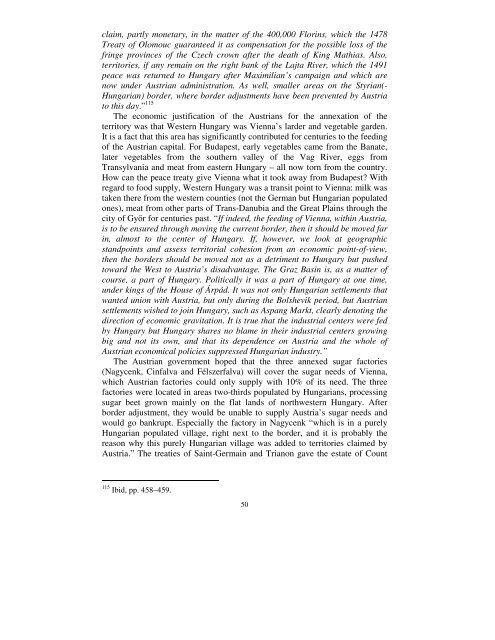The Fate of Western Hungary 1918-1921 - Corvinus Library ...
The Fate of Western Hungary 1918-1921 - Corvinus Library ...
The Fate of Western Hungary 1918-1921 - Corvinus Library ...
Create successful ePaper yourself
Turn your PDF publications into a flip-book with our unique Google optimized e-Paper software.
claim, partly monetary, in the matter <strong>of</strong> the 400,000 Florins, which the 1478<br />
Treaty <strong>of</strong> Olomouc guaranteed it as compensation for the possible loss <strong>of</strong> the<br />
fringe provinces <strong>of</strong> the Czech crown after the death <strong>of</strong> King Mathias. Also,<br />
territories, if any remain on the right bank <strong>of</strong> the Lajta River, which the 1491<br />
peace was returned to <strong>Hungary</strong> after Maximilian’s campaign and which are<br />
now under Austrian administration. As well, smaller areas on the Styrian(-<br />
Hungarian) border, where border adjustments have been prevented by Austria<br />
to this day.” 115<br />
<strong>The</strong> economic justification <strong>of</strong> the Austrians for the annexation <strong>of</strong> the<br />
territory was that <strong>Western</strong> <strong>Hungary</strong> was Vienna’s larder and vegetable garden.<br />
It is a fact that this area has significantly contributed for centuries to the feeding<br />
<strong>of</strong> the Austrian capital. For Budapest, early vegetables came from the Banate,<br />
later vegetables from the southern valley <strong>of</strong> the Vag River, eggs from<br />
Transylvania and meat from eastern <strong>Hungary</strong> – all now torn from the country.<br />
How can the peace treaty give Vienna what it took away from Budapest? With<br />
regard to food supply, <strong>Western</strong> <strong>Hungary</strong> was a transit point to Vienna: milk was<br />
taken there from the western counties (not the German but Hungarian populated<br />
ones), meat from other parts <strong>of</strong> Trans-Danubia and the Great Plains through the<br />
city <strong>of</strong> Győr for centuries past. “If indeed, the feeding <strong>of</strong> Vienna, within Austria,<br />
is to be ensured through moving the current border, then it should be moved far<br />
in, almost to the center <strong>of</strong> <strong>Hungary</strong>. If, however, we look at geographic<br />
standpoints and assess territorial cohesion from an economic point-<strong>of</strong>-view,<br />
then the borders should be moved not as a detriment to <strong>Hungary</strong> but pushed<br />
toward the West to Austria’s disadvantage. <strong>The</strong> Graz Basin is, as a matter <strong>of</strong><br />
course, a part <strong>of</strong> <strong>Hungary</strong>. Politically it was a part <strong>of</strong> <strong>Hungary</strong> at one time,<br />
under kings <strong>of</strong> the House <strong>of</strong> Árpád. It was not only Hungarian settlements that<br />
wanted union with Austria, but only during the Bolshevik period, but Austrian<br />
settlements wished to join <strong>Hungary</strong>, such as Aspang Markt, clearly denoting the<br />
direction <strong>of</strong> economic gravitation. It is true that the industrial centers were fed<br />
by <strong>Hungary</strong> but <strong>Hungary</strong> shares no blame in their industrial centers growing<br />
big and not its own, and that its dependence on Austria and the whole <strong>of</strong><br />
Austrian economical policies suppressed Hungarian industry.”<br />
<strong>The</strong> Austrian government hoped that the three annexed sugar factories<br />
(Nagycenk, Cinfalva and Félszerfalva) will cover the sugar needs <strong>of</strong> Vienna,<br />
which Austrian factories could only supply with 10% <strong>of</strong> its need. <strong>The</strong> three<br />
factories were located in areas two-thirds populated by Hungarians, processing<br />
sugar beet grown mainly on the flat lands <strong>of</strong> northwestern <strong>Hungary</strong>. After<br />
border adjustment, they would be unable to supply Austria’s sugar needs and<br />
would go bankrupt. Especially the factory in Nagycenk “which is in a purely<br />
Hungarian populated village, right next to the border, and it is probably the<br />
reason why this purely Hungarian village was added to territories claimed by<br />
Austria.” <strong>The</strong> treaties <strong>of</strong> Saint-Germain and Trianon gave the estate <strong>of</strong> Count<br />
115 Ibid, pp. 458–459.<br />
50

















